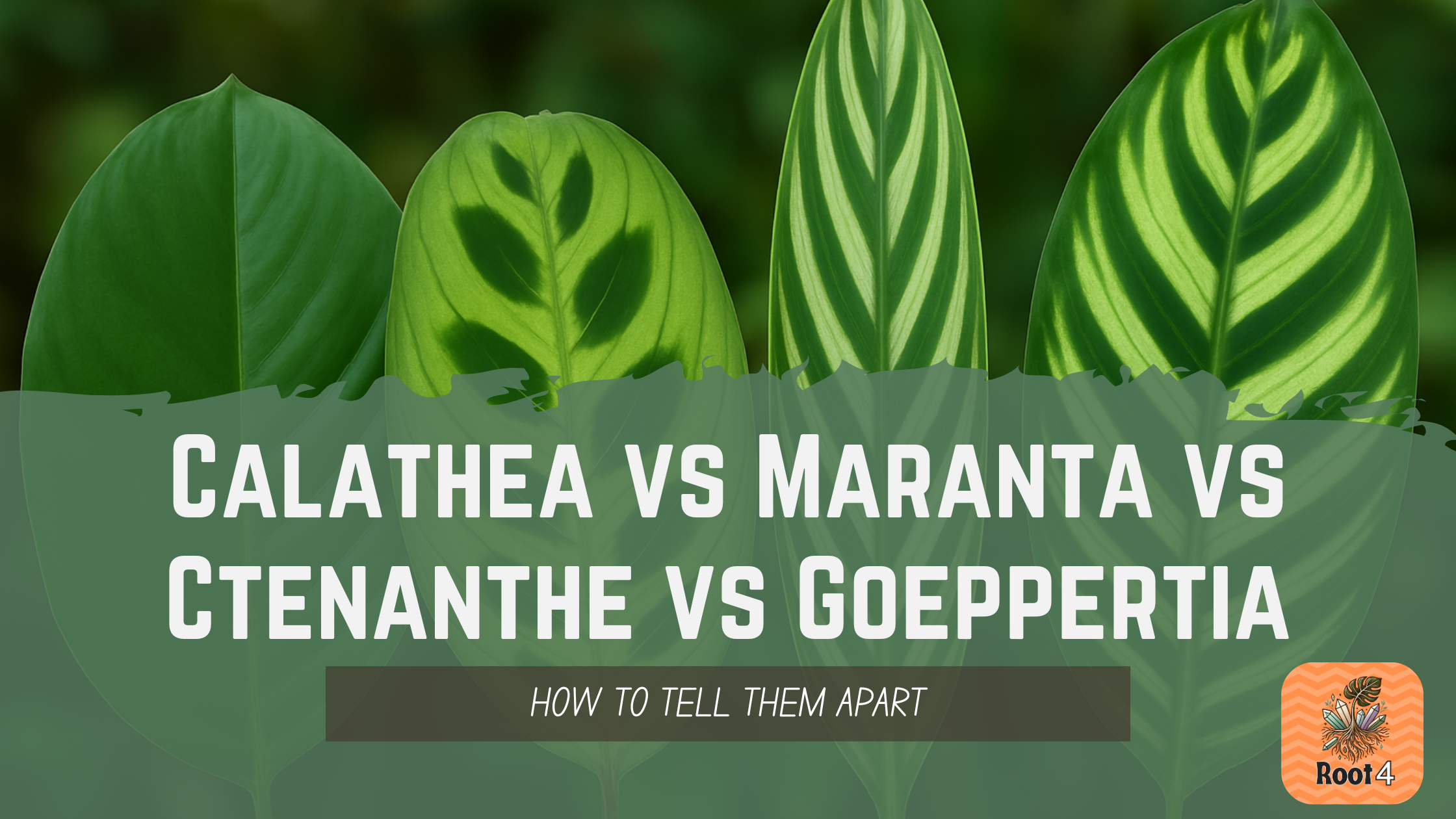Your cart is currently empty!

Calathea vs Maranta vs Ctenanthe vs Goeppertia: How to Tell Them Apart
When it comes to prayer plants, things can get a little confusing—especially when your Calathea turns out not to be a Calathea at all! If you’ve ever been stumped trying to tell the difference between Calathea (ka-LAY-thee-uh), Maranta (muh-RAN-tuh), Ctenanthe (tee-NAN-thee), and Goeppertia (GEP-er-tee-uh or JEP-er-tee-uh), you’re not alone.
These gorgeous tropical plants are all part of the Marantaceae family and are known for their vibrant patterns and captivating leaf movements. But they each bring their own flair—and care needs—to your plant collection.
Let’s break it down with a side-by-side comparison.
🪴 Comparison Table
| Feature | Calathea (legacy) | Maranta | Ctenanthe | Goeppertia (modern Calathea) |
|---|---|---|---|---|
| Common Name | Peacock Plant, Zebra Plant (older use) | Prayer Plant | Never Never Plant, Fishbone Prayer Plant | Rattlesnake Plant, Pinstripe, Orbifolia |
| Pronunciation | ka-LAY-thee-uh | muh-RAN-tuh | tee-NAN-thee | GEP-er-tee-uh or JEP-er-tee-uh |
| Leaf Movement | Moderate nyctinasty | Strong nyctinasty (folds up at night) | Minimal nyctinasty | Moderate to pronounced nyctinasty |
| Leaf Pattern | Wide variety, often feathery or peacock-like | Rounded leaves with herringbone patterns | Bold veining, fishbone or striped look | Wide range—oval to narrow with bold prints |
| Growth Habit | Upright | Low-growing, trailing or spreading | Upright, clumping | Upright, bushy |
| Leaf Shape | Oval to slightly elongated | Rounded to oval | Narrow, lance-shaped | Oval to long and narrow |
| Light Needs | Bright, indirect light | Tolerates lower light than others | Bright, indirect light | Bright, indirect light |
| Watering Needs | High humidity and consistent moisture | Prefers even moisture, less fussy | Consistently moist, not soggy | Moist, but allow top layer to dry slightly |
| Humidity Requirements | High humidity essential | Medium to high humidity | High humidity preferred | High humidity preferred |
| Temperature Tolerance | Warm temps, sensitive to drafts | More tolerant of temp swings | Warm temps, sensitive to cold | Warm temps, consistent environment |
| Propagation Method | Division | Division or stem cuttings | Division | Division |
| Difficulty Level | Higher maintenance | Easiest of the group | Moderate | Moderate to high maintenance |
| Pet Safety (ASPCA) | Non-toxic to pets | Non-toxic to pets | Non-toxic to pets | Non-toxic to pets |
| Key Differences for Identification | Often confused with Goeppertia; older name used for many bold-leaf types. | Short, rounded leaves with red veins. Trailing. | Long, narrow leaves with silver stripes or fishbone veins. Purple undersides common. | Includes many popular “Calatheas.” Oval or narrow leaves with stunning prints. Upright and bushy. |
🤔 Wait, So Is Calathea Still a Thing?
Yes—but barely.
Most of the plants sold as “Calathea” in the houseplant trade are now officially Goeppertia. Over 200 species were reclassified, including favorites like:
- Calathea orbifolia → Goeppertia orbifolia
- Calathea lancifolia (Rattlesnake Plant) → Goeppertia lancifolia
- Calathea makoyana (Peacock Plant) → Goeppertia makoyana
The Calathea genus still exists, but it now includes only a small number of species that weren’t moved over—most of which are rarely seen in houseplant collections. Still, nurseries and shops often use “Calathea” on plant tags for familiarity.
🔄 Which Calatheas Are Now Goeppertia?
Most of the “Calatheas” you see in plant shops today are actually Goeppertia. In 2012, botanists reclassified many species based on new genetic data, shifting them into Goeppertia to better reflect their evolutionary relationships.
Here are some of the most popular ones that were reclassified:
✅ Common “Calathea” Now Classified as Goeppertia:
- Calathea ornata → Goeppertia ornata (Pinstripe Calathea)
- Calathea orbifolia → Goeppertia orbifolia
- Calathea lancifolia → Goeppertia lancifolia (Rattlesnake Plant)
- Calathea makoyana → Goeppertia makoyana (Peacock Plant)
- Calathea roseopicta → Goeppertia roseopicta
- Calathea rufibarba → Goeppertia rufibarba (Velvet Calathea)
- Calathea zebrina → Goeppertia zebrina
- Calathea warscewiczii → Goeppertia warscewiczii
These are still widely labeled as “Calathea” in the nursery trade, so don’t worry—using the name Calathea won’t get you strange looks at your local plant shop.
🌱 TL;DR: Quick Tips for Telling Them Apart
- Calathea: Legacy name for many “prayer plants.” Still used but mostly outdated in classification.
- Maranta: Low-growing, rounded leaves with red or purple veins. Trailing habit and strong leaf movement.
- Ctenanthe: Narrow, lance-shaped leaves with silver or fishbone markings. Typically clumping. Purple undersides.
- Goeppertia: Most “Calatheas” you buy today. Oval or long leaves with bold patterns. Upright growth.
🌱 What’s Still Actually Calathea?
The true Calathea genus is now much smaller, with species you don’t typically see as houseplants. Most of these remaining species are either:
- Less decorative,
- More obscure in cultivation, or
- Native to very specific ecosystems.
Examples include:
- Calathea crotalifera – sometimes grown for its striking lobster-claw shaped flowers
- Calathea lutea – a larger landscape plant with paddle-shaped leaves and waxy bracts
- Calathea grandis – broad, bold foliage but not common as a houseplant
So while the genus still exists, most of the decorative prayer plants we know and love have officially moved on to Goeppertia.
👀 Quick Visual ID Tip
If you’re trying to tell these plants apart at a glance, here’s a handy shortcut:
- Calathea – Typically has solid green or subtly veined leaves, especially in the species that remain in the true Calathea genus. Less dramatic patterning.
- Maranta – Look for rounded leaves with red or purple veins and an iconic herringbone pattern. Often trails or spreads low.
- Ctenanthe – Has narrower leaves with striped or fishbone markings, often silver and green. Undersides may be purple.
- Goeppertia – Features the boldest patterns—from feathered, striped, to pinstriped—and often has oval to long leaves in upright clumps. Most “Calatheas” sold in stores are actually Goeppertia.
💡 If the leaf has dramatic graphic striping or contrast, it’s probably Goeppertia. If it’s more muted or solid, it may still be a true Calathea.
🌿 Conclusion
Whether you’re a new plant parent or a seasoned collector, understanding the subtle (and not-so-subtle) differences between Calathea, Maranta, Ctenanthe, and Goeppertia can help you provide better care—and show off your plant knowledge with confidence.
While plant tags may not always keep up with taxonomy, your attention to detail will make all the difference in keeping these beautiful prayer plants thriving.
Have a favorite among the four? Drop a comment and let us know what’s growing in your space 🌱

Leave a Reply